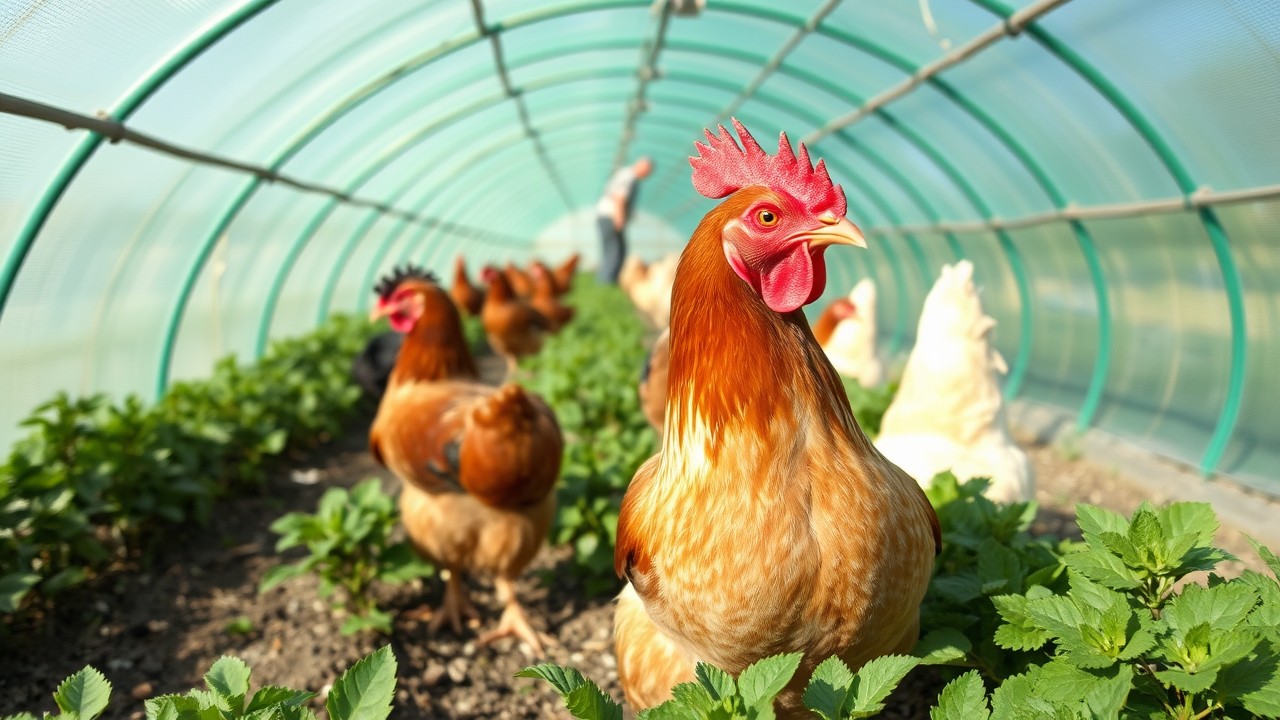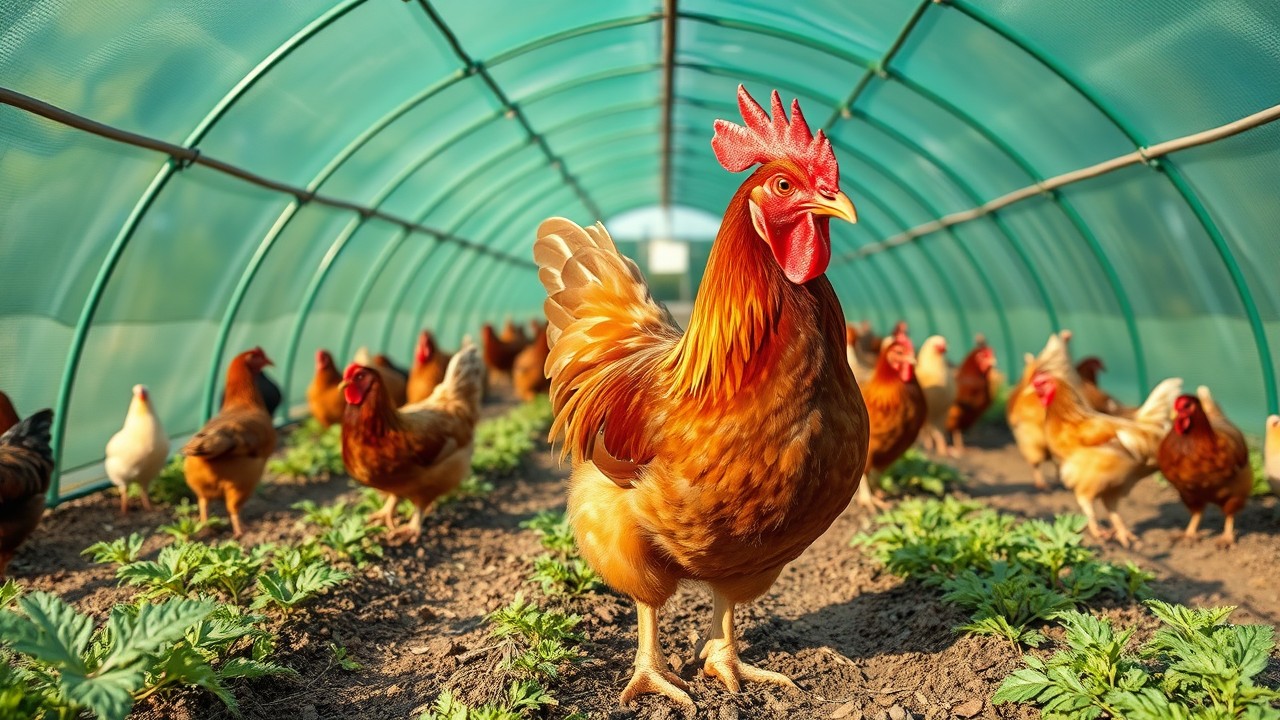Often, thoughts of winter conjure up images of cold temperatures or gray skies, reminding us to prepare for the coming months. In cold climates, it also means it is time to close the greenhouse and engage in other indoor activities to pass the time until the start of another growing season.
However, it is possible in all but the most severe climates to grow crops in your greenhouse year-round if you take precautions to keep the growing environment at proper levels. In order to decrease expenses while still enjoying the benefits that year-round gardening offers, chickens have been incorporated into greenhouse systems.

Benefits of Housing Chickens in a Greenhouse
You should be aware of the key advantages of housing chickens in a greenhouse, turning a seasonal challenge into an opportunity.
Enhanced Plant Growth and Productivity
Chickens in a greenhouse can improve plant growth through their innate behaviors. While foraging, they aerate the soil and enhance root development. Using chicken manure as fertilizer, enriching the soil and elevating nutrient levels. This mutually beneficial relationship between plants and chickens fosters healthier plant growth and substantially increases garden productivity.
Natural Pest Management
Chickens excel in foraging, actively seeking out pests and insects harmful to your plants. Letting chickens roam in the greenhouse establishes an effective, natural pest control method. This organic strategy minimizes reliance on chemical pesticides, promoting healthier plants and a more sustainable growing environment.
Consistent Egg Supply
The greenhouse chicken coop system offers a major advantage: year-round access to fresh eggs. In contrast to conventional chicken coops, which suffer from environmental fluctuations, a greenhouse's controlled climate keeps chickens warm in winter. This arrangement promotes uninterrupted egg production, ensuring a reliable supply of nutritious eggs at your table, no matter the season.
Lower Heating and Labor Expenses
Managing a greenhouse in winter incurs significant expenses. Heating and labor costs rise sharply. However, integrating chickens can enhance energy efficiency. The birds generate natural body heat, which aids in preserving warmth and lowers heating expenses. Furthermore, chickens assist in pest management, streamlining your overall workload and enabling you to concentrate on other tasks.
Sustainable Composting Practices
Chickens generate considerable organic waste that can serve as an effective resource for composting. The mixture of chicken manure and kitchen waste forms nutrient-rich compost, promoting soil vitality. Implementing a greenhouse chicken coop system supports an environmentally sustainable cycle of waste management and nutrient recovery, thereby enhancing your gardening initiatives.
How to Build Your Greenhouse Chicken Coop
To successfully set up a greenhouse chicken coop, meticulous planning and attention to key factors are essential. Here, we explore vital elements that will help you create the best environment for your chickens and plants.
1. Location and Position
Selecting the optimal site for your greenhouse chicken coop is critical. It maximizes sunlight and sustains an insulated space. Ideally, position the greenhouse to harness the maximum sunlight daily. This approach not only warms the air but also fosters robust plant growth. Furthermore, you must strategically place nesting boxes within the greenhouse. Locate these boxes in sheltered spots. This ensures they receive warmth while minimizing drafts. Such considerations guarantee your hens' comfort year-round.

2. Temperature and Humidity
The temperature must not exceed 75°F, while the humidity levels should be maintained at around 50% for optimal comfort and conditions. Excessive heat or cold can lead to chickens' adverse health conditions and plants' low productivity. Use thermometers and hygrometers for accurate monitoring, enabling prompt modifications. Additionally, introducing plants that regulate humidity can establish a balanced microclimate in the greenhouse.
3. Ventilation
Adequate airflow reduces the risk of overheating and decreases humidity accumulation, promoting health for both chickens and plants. Place adjustable vents at the top of the greenhouse to facilitate the escape of warm air and the entry of cooler air from lower openings. Additionally, employing exhaust fans can improve airflow quality during hot periods. Ensuring greenhouse ventilation for poultry fosters a healthy environment and minimizes respiratory problems in chickens.
4. Predator Prevention
Safeguarding your chickens from predators is essential when setting up a greenhouse chicken coop. Utilize strong materials to reinforce the structure. Ensure all entry points, including doors and vents, are secured with durable mesh or hardware cloth. This increased security not only protects your chickens but also allows them to roam safely within the greenhouse.
5. Plant Protection
Chickens bring many advantages, yet they pose a risk to your plants by pecking and digging. Thus, it is essential to adopt protective measures to help your plants flourish. Wire enclosures can establish safe zones where chickens can forage without harming fragile plants. Moreover, consider hanging plants or employing vertical gardening methods to lift them out of chickens' reach, all while optimizing space. These strategies will allow you to enjoy the benefits of both chickens and plants in a balanced way.
Chicken Care and Greenhouse Management
Here, we share important tips on chicken care and greenhouse management, which will help you build a sustainable and balanced ecosystem.
Chicken Breeds
Choosing the appropriate chicken breeds is essential for effective poultry management. In extreme-temperature environments, breeds like Rhode Island Red, Leghorn, and Orpington excel. They perform well in fluctuating climates and sustain reliable egg production. These breeds offer resilience and high laying rates, providing a consistent supply of eggs while adjusting smoothly to greenhouse environments.

Bedding and Composting
Utilizing absorbent materials like straw or wood shavings aids in moisture management, odor control, and maintaining a hygienic environment. Moreover, efficient composting of chicken manure is imperative. Using the deep litter method for chickens and routinely turning and managing compost heaps, you can considerably reduce foul smells and generate nutrient-dense fertilizer that improves soil quality for your garden. This practice not only supports plant development but also minimizes waste, fostering a more sustainable living environment.
Feeding
A well-balanced diet is crucial for keeping chickens healthy, which in turn benefits your greenhouse ecosystem. Make sure your flock consumes high-quality commercial feed that fulfills their nutritional requirements. Enhance their diet with kitchen scraps like vegetables, fruits, and grains. This practice diversifies their intake and reduces food waste, fostering sustainability. Moreover, allowing chickens to forage encourages natural behaviors, resulting in improved overall health.
Cleaning and Odor Control
Consistent sanitation of the coop is essential for promoting a healthy habitat for chickens and plants alike. Create a consistent schedule that features daily inspections to clear away waste, alongside routine thorough cleanings of the coop's interior. Utilize odor management strategies, like natural absorbents such as diatomaceous earth, and ensure proper airflow to help reduce unpleasant smells. This approach fosters a more inviting atmosphere for both the chickens and greenhouse patrons.
Implementing the tips outlined here will not only help your greenhouse chicken coops reduce expenses, but also optimize productivity, leading to a more satisfying environment for chickens, plants, and everyone involved. Take action now to enhance the efficiency of your dual-purpose agricultural buildings!








